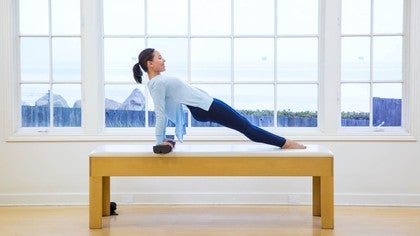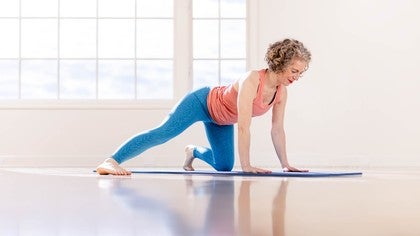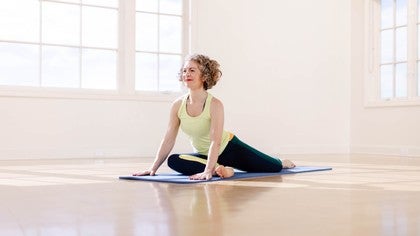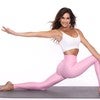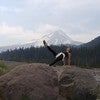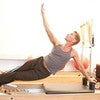Description
About This Video
Transcript
Read Full Transcript
Hi there, everyone. I'm Claire Sparrow. Welcome to class today. We're going to be exploring a class where we adapt the mat work. So familiar movements from the mat work repertoire, and we're adapting them to suit you if you are working through or experiencing any pelvic floor dysfunction. So it's just a little ways into doing those movements and perhaps some queuing and imagery that's a little bit different. So to start class today, we're gonna go ahead and lie down.
So lay down on your back, bend your knees, and take your feet around shoulder width apart. So they're not really wide. They're not as wide as your mat, but about shoulder width. And just take a moment to settle in check-in with your breathing, like the back of your body, open into the mat underneath you. Check that you're gazing up at the ceiling and not tucking your chin and looking forward.
So just make sure that you've got those natural curves in your neck here. We're gonna start with a movement through our feet and then we're gonna lead into some bridging. So bring your feet a little bit closer towards you as you would have them for bridging, but do keep them shoulder width apart. Let's begin with our toes. So you're gonna lift all ten toes So make sure the little toe comes up as well and then spread them out and place them all back down.
Don't worry. You don't have to do piano tours. Just lift them, spread them, and bring them back down. Make sure your little toe. Often the little toe doesn't quite wanna peel away as much. So let's make sure it comes up and then place it down. Go ahead and do that one more time.
So you're addressing all ten toes, and then they meet the mat. All ten toes meeting the mat. Keeping all ten toes down, bring your heels up like you're wearing high heel shoes. And then to lower them instead of them going straight down, you're gonna stretch them back towards your bottom and then place them down. And again, lift up into high heels and then stretch your heels back.
We'll go one more time, connect all ten toes, stretch your heels back. So now you've got a really clear footprint on the mat. Bring your knees together. I know it's slightly controversial. But stick with me. So you got your knees together.
You got your feet anchored. Let's spread and stand into your toes so that you feel that your sacrum can become light. So that's that curved dish like bone between your cheeks, it's gonna float up, lift up, and feel openness through the front of your hips, and then let it go. Is if your sacrum is gonna do a lunar landing down onto the mat. And, again, standing into the footprints of your feet so that your sacrum becomes the leader of this bridging movement, not your glutes, which hopefully, because we've turned our knees in, they're a little bit more at ease and not so Giddy trying to do all of this movement for us. Let's make this one our last one. I'm bringing it all the way back down.
So we're gonna do another little variation on bridging, where you're using your tailbone to move from side to side. So go ahead and come up just as you are really being mindful over your sacrum leading, not your glutes. And then on the way down, you're gonna move your sacrum and your tailbone side to side, like a snake gradually moving through the sand as you come all the way down. And again, find the footprints of your feet, feel your sacrum. It's like the inside of your sacrum lifts you and then you release it.
It's leading forwards and down. We're gonna do one more like this. It's a really great way to wake up your spine side to side. All the way down. And a great way to make sure that your pelvic floor is wakening up towards the back of your pelvis. Okay. Go ahead and bring your feet together. So you got knees together and feet together now, float your arms up towards the ceiling.
We're gonna go into variation of the 100, which is so good for your pelvic health, standing into the footprints of your feet, lift your sacrum up as we did bring your arms by your side, but hovering on the mat. Pause here for a little body check So your knees stay together. So they're not splaying out. Keep them together, and that might be quite intentional to feel that knees together. And you're making sure here that your rib cage hasn't come above your hip bone.
So let's keep that runway. Then we're gonna pulse our arms. Yes. Just like the 100, but you're gonna do it here where we've created a supportive position for your body to be in where your pelvic floor can be challenged, but it's not going to be loaded in a way that makes it compromise. So how can we challenge it without compromising it? So you're beating your arms.
All the same beautiful things apply from our standard general 100, except you're here. So you're beating the entire arm. It's not your hands flapping at the end. You really beating your entire arms, bring your awareness back to your sacrum lifting every time your glutes start to take over And then we're gonna flow our arms up towards the ceiling pause here. Let's do some circles.
Think about your double leg stretch and the circling our movement that we would do in our double leg stretch. Keep your knees together. I feel mind drifting away. So I know you will be too. So let's bring our awareness back to our knees staying connected. Again, as you take your arms over, your rib state, and your body reverse your circles.
So the challenge here is as your arms come reaching overhead, can your knees reach forwards as if you were stretching your legs away in the double leg stretch. Let's do one more circle all the way around and then float everything back. Down. I definitely feel awake now. I'm sure you feel the same way. We're gonna pause here and check-in with how our body feels from that.
Great. So now we've come down from that bridge. Hopefully, you feel really anchored into the back of your body. Ready to explore some one leg circles. So go ahead and extend your left leg long along the mat. To set ourselves up for this, we're gonna fold the right knee in and put your right hand, just kinda cupping around the the top of your knee to help you to give the leg back into the socket. So let's start with some really simple circles.
The great thing about doing your bridging before this one leg circle is you've got a very strong sense of where your sacrum is as well. Because as we're circling our leg in the hip socket, the sacrum is where our center of gravity is. It's the balance point. It's the place we move away from. Let's circle the other direction.
And we're gonna let the breath flow in and out. We're not gonna be too fussy about the breath here. Just make sure you are. And as you're circling, a little trick is to imagine your actual hit socket. So if you think it's about where your groin is, imagine it being a little bit closer to your pubic bone So as you're circling, you're going to really get into the depth and that juiciness of your hip socket. Okay.
So we're gonna rest there, and we're gonna start to unfold our leg up towards the ceiling. We're gonna do this by circling your foot and your ankle, and it's a twisting action. I often think about that image of you know, the the snake rising out of a basket, you know, the sort of magical idea. So you're just sending your leg up. We're not gonna judge ourselves at this point for how straight or not straight, and you're gonna twist in circle to bring it back down. Because the goal is that by twisting in this more sympathetic way towards straight, is we will get a little bit more length with each of the repetitions that we do.
So your twist sting and circling as you bend. And then let's circle the other way. So you circle. It kind of gives your shin bones the information to twist and roll and your leg unfolds. And we'll do one more of those to bring ourselves up to straight or straight ish.
I like to give the ish because each day is a different day. Okay. So wherever you are, you are. And the leg as long as long as it can go. And let's do some little circles in the hip socket. So we're not doing the big full circle where the hit comes off, we're really concentrating on being in the socket.
Remember the trick? Think about it being narrower than it is and then circle the other way. We also have to have the sacrum weighted down the back of your ribs, shoulders, arms, all of those things. Really feel the depth of the socket. Last couple and then fold your leg extend it along the mat. And I always need to just check because it definitely feels like my right leg is longer than the left. Like, hopefully, you feel the same way, and it's such a great sensation that you've been able to release all the tension holding in your hip socket. So you've got your full length, your full height, which is important when you're only short like me.
So you're gonna take your other leg. So we've got left leg left hand, you're just cupping your knee and pause here before you begin. So you feel the drop of your sacrum your center of gravity, meeting the earth below, your ribs draw pain, your diaphragm sitting in your ribs, and heavy. And then we can start that circular motion in the hips. Okay. Circular than you think and also giving a bit of weight. Can you send your leg into the hip socket?
Sanding it down, and then go the other way. Now you might find especially those of us that have had children, if you've had, vaginal birth, and there's a birth injury in your pelvic floor, you might find a little bit more tightness restriction. There might be a kind of Almost. I know we're doing a circle, but, like, there's a corner you can't quite reach. And this is gonna help you so much in releasing that scar tissue and releasing that.
So let's go into our unfolding. So you're circling your foot spiraling. Think about this snake. You know, somebody's playing a little flute, and it's rising. So you circle your shin bones are moving on each other. And don't worry if like me, you end up changing direction halfway Just keep that spiral and motion going and calming up. Twisting your foot.
So each time lead with your foot. That's the head of the snake rising. Twisting down into the hip socket. Again, remember where your sacrum is. This time we'll go up, we'll pause up for our circles.
All the way up. Find the length of your leg. Whatever that is straight ish is fine, and we're from here. We're gonna stay long, and we're gonna circle across and around. In the socket. Remember what it felt like when you were holding your leg into the socket?
Can you let the weight of your leg? Drop down. Tell that excess muscular effort to let go. And then go the other way. So if you feel that click and pop feeling into your hip socket, you know you need to think about narrower. So make sure you've changed direction.
Think of your hip sock as narrower. Last little circle, and then bend, lengthen your leg out feel, hopefully, you've got 2 long legs, so you won't be walking in circles. So now we're gonna go ahead and lie on our site for some variations on our sidekick movement. So we'll have our underneath leg bent, underneath arm bent, so it creates a little pillow or a cushion. And then your top leg is gonna be straight and rest it along the mat.
So you've got it over the bottom leg and long. First thing we're gonna do is some hip hitches. So we're sliding your foot away from you and lengthen down from your inner thigh away. And then like a spring recoiling, just let it come back again. Reach away from the inner thigh.
And let it recoil. Another place to concentrate on as you're doing this movement is from your sit bone. So at the back of your pelvis reach away and then recoil. So inner thigh, back of pelvis reach away, and then recoil. Often, like we said before, if you've got some scar tissue, if there's an injury there, if you've maybe had some surgery, it can feel a little bit restricted. So even if you're not moving at all, but you're thinking about moving, that will be fantastic.
Is better to do that than start to move from your lower back or elsewhere in your body. Let's make this your last one. And then we pause with your hip bones one on top of each other. We are starting with your leg down because I want you to have that big range of movement and we're gonna lift your leg up and lower your leg down. You can put your hand on your hips so that that curve bone, the side of your pelvis here, to give you a little bit of feedback, little bit of information. As you're lifting up, your waist at the top, the goal is that it says the same length and it doesn't shorten.
There we go. Think about your sit bone again. So at the back of your pelvis, your hamstrings at the back of your leg, think about picking them up towards the ceiling. We often go straight into kicking our leg forwards and back, and we do that with the holding pattern at the back of our pelvis that we get from sitting or excess pelvic floor tension, And this way, we make sure we set ourselves up for really good kicks. So we're gonna have the best kick of our life today, lift to hip socket height. You're gonna kick forwards, point, and go back. Kick forwards, point, and go back.
So as we do this now, you've got so much space that you created at the back of your pelvis, your kick is just gonna be amazing from now on. Let's do once more, kick, and then back rest there. Great job. So we're gonna go ahead. Let's do all of that on the other side. Taking yourself onto the side of your body.
Bend your underneath leg and your underneath elbow. Your top leg is going to be straight out foot flexed hand in front or on your hip for feedback. So go ahead and do your hip pitches. And always, we're so naughty ourselves. We compare as soon as we go from one side to the other.
And if we can compare with curiosity, with interest, it's really healthy, and it helps us to learn more about ourselves. So do that. So we go, okay. It's different on this side. How curious. We've got more range of movement or maybe I need to do more on this side or more on the other side.
Make about your growth and your body and your understanding of yourself. 2 more hit pitches. Remember inner thigh leading, inner thigh reaching away and recoiling last one. And recoiling. Make sure your hips are stacked on on top of each other.
You still got both feet flex, and you're gonna float up and down, sitting bone, back of your hamstrings, really pick them up towards the ceiling. Picking them up on the inhale, luring them down on the exhale, picking them up on the inhale, lowering on the exhale. If the breathing pattern is a distraction, please don't worry. Just make sure you are breathing in and out and focus on the quality of your movement here, lifting up from the back of your leg. Last one. And then we're gonna go ahead and come to about hip socket heights.
So maybe not as high, and then we'll do our kick. So you kick forward point back. Feel your bottom really able to expand the back of your pelvis, the back of your leg can lengthen because we've set it up for the win. Set it up for the best kicks of your life here. We'll do 2 more. Last one.
Nice big kick, and then rest there. Well done. We're gonna come up for some kneeling movements now. We're gonna be starting off sitting with your bottom on your heels. You're gonna gaze straight forwards and reach your arms out in front. Think back to the bridging movement we've already explored where you were leading with your sacrum.
So you're taking your shins down and your sacrum forwards and then come back again. Send your shin so along the front of your ankles go down and your sacrum comes forwards. Let's go again. Send your Shinsdown seat from forward. Okay. I felt like I got it there, so I'm sure you're getting it now too.
Send your shins down sacrum. Really feel the inside of your sacrum move forwards. This time we're gonna go up, we're gonna stay there. Great. So we're up in this beautiful, open, high kneeling position. You can bring your heels together, connected, And then we'll do a teeny tiny hinge and then come forwards.
This time as we come forward, sweep your hands to the back of your head, and then they come in front. Sweep them to the back of your head, and then they come in front. When you bring in your hands to the back of your head, there's gonna be this temptation to thrust your ribs. We're not gonna do that. So we're definitely gonna keep our ribs inside our body as we sweep the hands.
We'll go one more time. Okay. Well done. So for the next that we're gonna come into that position and stay there. So you're gonna have your hands here. And that's your position from now on.
You remember your sacrum's come forwards, and then we're gonna do a mermaid from side to side. So you're gonna come up and over and return. Keep your heels together like we did before, and that's gonna help you to feel the internal lift up through your sacrum, through your pelvic floor. As you go over Keep your pelvis verticle. There's a tendency to push you out to the side, and I really want you to focus on this mermaid piece.
We're doing this in preparation for our sidekick in the kneeling position. You can imagine between your shoulder blades, it's like a dial that you're turning. So it really is that upper part. Okay. So we're getting ready now. We're gonna kick our leg out.
This is where anything could happen. It's an adventure. We'll see. You're gonna go to the side whichever side it is, and then kick your opposite leg out in the hand comes down, catch yourself wherever. So that's okay. We're here.
Your sacrum is gonna be four words just as we did before. From this position though, we need to get up. So you're gonna scoop your knees towards each other and come back up. We did it. Well done. Let's go again. We go over as far as you can, and then kick your leg out.
From here, scoop it back in. Little trick here on that side. We've got this, though. We go as far as we can, kick the leg out. You can be flat.
Hand her fingertips. It's okay either way. I'm a go again. Make sure you're breathing and then scoop in once more either side. Absolutely fantastic for that control through the inner seam into your pelvic floor. Scoop it in and pause there.
Well done. Great job team. We're gonna come down and do some more mermaid type movements, and we're gonna explore the position that we sit in first of all. So to do that, you're going to start with a kind of quite open, wide zed sit position. You can use your hands to support you or they can be in the air. And we're gonna roll across your pelvis from one side to the other. Really rolling. I'm gonna put my hands down for a few So I can go slow motion through the back of my pelvis.
Think of this as a massage you are massaging out the tension that might be stopping you from sitting in your zed set with ease. You know, it's so important we have that base. I'm gonna go hands free. Look. No hands. Let's see. Rolling as much as you can.
Across your pelvis. So we're gonna go ahead and go to one side and pause there. Bring your front leg into a kind of right angle and you're facing towards it. The back leg scoot it out the way as far as you can without any cramp creeping in. So it's just wherever you can. Place your hands out in front of you, lift your chest up, and you're just leaning into squaring your body as much as you can.
To this front leg here and just breathing here. Your hands are spreading on the mat. You're breathing. This is quite deep into this. Front inside of that, hip, breathing.
Great. So in this position, as you're breathing, you keep stealing yourself across towards the center, pull through your hands and lift your chest up so you're fanning out your chest feathers, And at the back of your pelvis, can you find out your tail feathers? Can you let your tail feathers spread behind you, and that will deepen into your hip into the back of your hip. Keep breathing. Holding. Alright.
Well done. That's one you could come into. Let's find your regular zed sit position now. Wow. That feels so great. So hopefully you feel really anchored down into that side.
Reach your arms out. Hold that imaginary beach ball. And we're just gonna do a few of our plain mermaids. You can go straight over from side to side and feel how your roots are holding you down whilst you move freely like seaweed from one side to the other. Enjoy your movement.
You can think about all the things that, you know, to think about, imagining that you're staying within double glazing, all of that good stuff. And we'll make this our very last one address. Let's come into the zed sit stretch to the other side now. You're bringing your leg in front of you, so it's at a right angle. The other one scoots out of the way.
And then bring your hands forward, lift your chest up, gaze out to the horizon, Breathing here. Let your body meet your leg and your hips. And you're gently with your hands gently pulling towards you lifting your chest feathers up, and don't forget your tail feathers filing out behind you as well. Breathing. Remember to keep square in yourself, send to ring yourself to that shin in front.
Okay. Well done. Bring it to center for your mermaid proper, reaching your arms out to the side. Feel the grounding. There's a real drop into your pelvis here, which allows you to have the most glorious, mermaid. Be free. Be liberal. Let your body move from side to side.
Feel how your pelvis can support you with this movement. It's bringing you back and it's paying you out. It's paying you out and over and bringing you back. This is your life. 1.
Great job. We're gonna come into a quadruped position now. I love love love to come into quadruped having just on that exercise because you can really feel your legs into your sockets. It's easy on your lower back you can find your alignment so, so easily. We're gonna start here with a very simple quadruped opposite arm and leg, bird dog, whatever you want to call it, you're gonna slide your foot along the mat and your opposite arm out. Pause here. Really stand into the standing hand and shin.
Sounds obvious, but sometimes we're kind of like levitating away. Use them. Stand into them. We keep going. I want you to pay attention to your second toe and your middle finger. I'm not being rude, but those two points will really help you to move in good alignment. So we'll stay out and pause here.
Standing your standing hand and shin. Flout your back foot just a millimeter or 2 off the match. We're gonna open and close. Open and close. Think about this sidekick. We did that movement of lifting and lowering, 1st of all, one last one, and then return. Let's go ahead and do the other side.
So you stand into the remaining hand in shin, reach away, Let your toes just fall off ready for open and close. Think of your sit bone opening, your inner thighs, your back of your legs, your adductors, and hamstrings, they have to lengthen. It's tricky, but you can do it. 2 more. Opening. And there we go. Well, done.
Pause off your wrist. Do a little circle if you need to. Ready to go into our next piece. So leg pull front is such a fantastic exercise, and I think sometimes can be one we avoid when we've got any pelvic floor conditions. So you're gonna bring your right knee forward and extend your left leg back.
So you're not in a full leg pool. You're in a half one, and you're staggering it. And we're gonna rock back and forth just like you would do. Push through your toes. Push through your toes. I really like you to connect into the second toe to push, and that will help to create more support, more information coming into your pelvic floor.
Then you're gonna tuck your other toes on your right foot tuck those under 2. What's gonna happen is as you're rocking, you're going to lift your knee off. So as my left heel goes back, my right knee comes off. Off. It's almost like you know, you're gonna do a running race and you're in the starters blocks, that's the feeling. So you push through the second toes in both feet. Once more on this side, and rest there.
We'll switch over to the other side. Your left knee comes further forward it's no longer directly under your hip. It does come further forward. Remember, it's the starter's blocks. We'll lengthen it to start with. So we just do the rocking push on your second toe.
Push on your second toe. Getting into the feeling, then we tuck under the left toes, and we're doing the same thing. So as your heel goes back on the right, your knee is coming forward. Push. Connect through your toes. We used our feet at the beginning so that we would really be ready for this. Your inner knees reach away from each other.
So the inside of the front knee goes forward and the inside of the back knee goes back. We'll make this your last one. It's quite exhausting. Circle your wrists if you need to. Alright. We're on the home straight.
You've done so great to be on this adventure with me. We're gonna sit towards the front of our mat, which you've guessed it means there's some kind of rolling about to happen. We're gonna do a little variation on seal. So to start with, bring your legs into a diamond like position, and you're gonna pick up your left leg like a baby. You're gonna cradle it towards you and just be there.
Take a moment, holding your leg in feeling how strange it is to hold your own leg. And then you're gonna rock it Again, like a baby, forwards and back or side to side, I should say. As you're going side to side, there's gonna be a temptation for your whole body to follow the movement. I really want you to find, even if it's just teeny weeny, the movement of your leg in the hip socket opening, closing, opening, closing. Just that rocking.
And letting your breath start to settle. And we're good. Find the middle point now. And you're gonna start to look at your foot. So I'm looking at my foot. I'm gonna lift with my arms the leg up. So you're lifting your leg up until there is no other choice, but to roll.
There is not gonna be any other choice but to roll. We're gonna do one more just like this. Tip your foot and roll. And we've done Well done. Let's do the other side. Oh, yes. To to that little notice saying, again, there's more drop into the hip.
It's like magic Let's go ahead and grab the other leg, cradle it like a baby, settle into it, make sure that you are sitting upright, and then we can rock it. Just cradling and rocking, cradling, and rocking, really think about the leg moving in the socket, like, the hip, the hip circles we did, the one leg circles. We've done the sidekicks. We've done a lot of movements teaching you how to do this. And then find the middle point and then lift your foot up. Look at it. Be curious.
Be curious. And then there's just that biting point where the roll just happens. There's no effort. It just happens. You're looking. You're looking.
You're looking. I know there's a little bit of effort, but, you know, go go go go go and roll. Okay. Well done. We're gonna put that together. So we've got our diamond like position.
Your hands are gonna dive in and under. So you've got your shin, your ankles, your feet, wherever they can really reach. And then creep your feet in a little bit. We're gonna balance on the back of our pelvis so your feet just come off and go ahead and do the open, close, open, close. We just did it. We did it with both, with each legs on their own, and now we're doing it with both.
Now from here, just as we did, start lifting your feet, you're curious, you're looking at them, and you've rolled and your backup and your opening and closing and opening and closing and opening and closing. And then you get curious. You look at your feet and you roll. It's like magic. Last one. And, of course, we've got variations where we can do the opening and closing at the top, but we're just focusing on that one today. So that was your seal broken down for pelvic health.
So now we're just gonna stand up and check how we feel in our bodies. So come bring yourself to standing. Arms long by the side of your body feet just slightly apart. And maybe even close your eyes if it feels good to do so. And just scan your body from head to toe.
Noticing the sensations and feelings that you have now. At the end of class, We've adapted the mat for your whole body pelvic calf. So, hopefully, as you stand here now, You feel that. You feel connected to your whole body and your pelvic floor as this vital center of your whole body function. And then slowly letting the light come in through your eyelids blinking them all pen and celebrating yourself for a moment. Well done, everyone.
Thank you so much for joining me in class. I can't wait to see you in our next class.
Beginner Mat Workouts: 30-Minute Classes
Comments
You need to be a subscriber to post a comment.
Please Log In or Create an Account to start your free trial.
